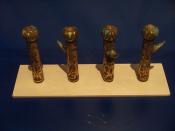This chapter first talks about the usual practice of Han origin on choosing empresses; dethronements by dowager empresses; harem disputes leading to the murder of imperial wives and their children. The second part tells us the variety and political ingenuity of marriage systems designed by the leaders of the conquest dynasties illustrated by TÃÂo-pa state of Wei, the ChiÃÂ-tan Liao Dynasty and Mongol Yuan.
Women played important roles in the Han regime. For empress dowager, when her husband died, she might become head of the ruling house and on many occasions de facto ruler of the empire. So they can choose the heir, appoint the empress, and put relatives in the important position. But before being an empress dowager, the position in the early years of career might be unstable. They might be demoted, discharged by either emperor or empress dowager. Another role, the princesses on Royal family were weak position when it came to succession.
Nevertheless, as they are the permanent member of the ruling line, the social status of the princess was higher than that of the imperial mother or wives.
For the TÃÂo-pa Wei, they separated the wifeÃÂs biological function of producing an heir from her political role. Mother of eldest sons was never appointed to the rank of empress in their lifetimes and might be ask to commit suicide after the son was named as heir. Besides, some measures were taken to control the ambitions of agnates centered not on supervising their marriages, but on bestowing equal rights in selection for office.
For the ChiÃÂi-tan Liao, all branches of the imperial house and those of consort were ranked according to degree of kinship with the founding emperor and empress. The highest-ranking branches of the ruling family married into those of the consort clan. But later,

![Qing Court Return, The Emperess Dowerger [1902] George E. Morrison [RESTORED]](https://s.writework.com/uploads/8/86488/qing-court-return-emperess-dowerger-1902-george-e-morrison-r-thumb.jpg)
